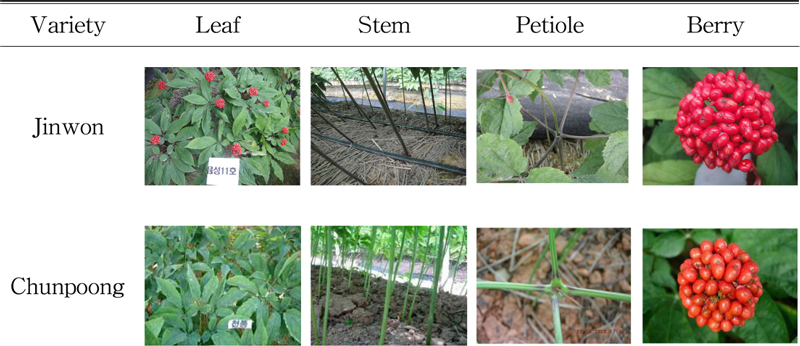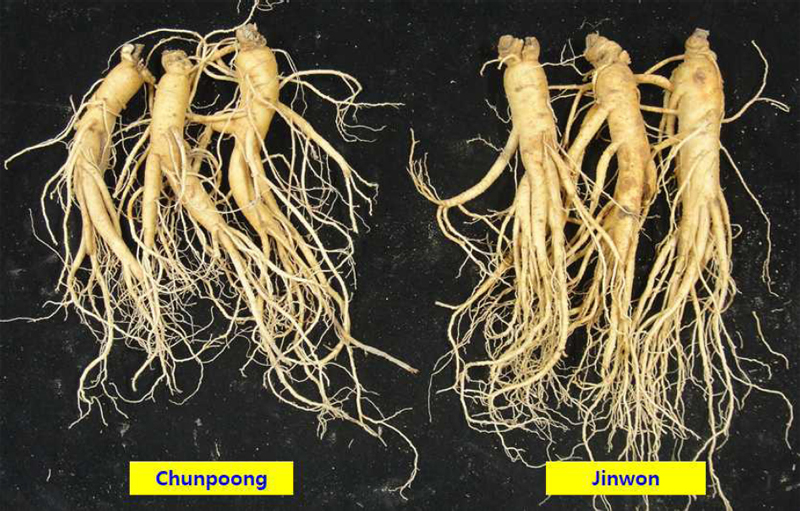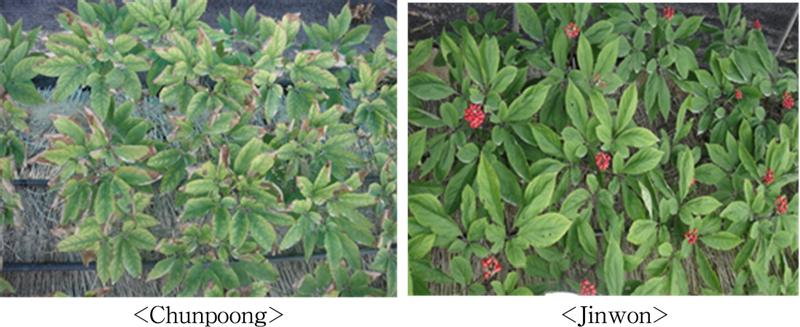
내고온․다수성 인삼 신품종 ‘진원’
This is an open access article distributed under the terms of the Creative Commons Attribution Non-Commercial License (http://creativecommons.org/licenses/by-nc/3.0/) which permits unrestricted non-commercial use, distribution, and reproduction in any medium, provided the original work is properly cited.
Abstract
Stable production of Korean ginseng (Panax ginseng C. A. Meyer) is highly dependent on specific climatic conditions. Recently, ginseng yield and quality have been negatively affected by climate changes, particularly by global warming. Therefore, developing new varieties with enhanced tolerance to high-temperature stress is essential for coping with elevated temperatures.
To increase the production stability and enhance the yields of Korean ginseng, a high-temperature stress tolerant elite line with a high yield was collected from a farm field in Pocheon, and a new variety, ‘Jinwon,’ was developed using a pure-line selection method. ‘Jinwon,’ which has a green leaf and red berry, exhibits red leaves at senescence and a convex leaflet shape in cross section. ‘Jinwon’ sprouted two days earlier than ‘Chunpoong,’ and its flowered and fruit-ripening period occurred three days earlier. ‘Jinwon’ has approximately 28% higher 4-year-old root yields (576 ㎏/10a) than that of ‘Chunpoong’ (519 ㎏/10a). The ginsenoside content in ‘Jinwon’ was 25.9 ㎎/g, which was higher than that of ‘Chunpoong’ (10.9 ㎎/g).
‘Jinwon’ exhibited strong resistance to high temperatures and Alternaria blight, with higher yields and better functional properties than ‘Chunpoong’. As a result, ‘Jinwon’ was registered as a variety (grant number 7461) with the Korea Seed and Varieties Service in 2019.
Keywords:
Panax ginseng C. A. Meyer, High-temperature Tolerance, High-yielding, Jinwon, Korean Ginseng, Variety서 언
소득 수준의 향상과 건강을 지향하는 소비 트렌드로 국내 건강기능식품의 시장 규모는 매년 성장하고 있으며 2021년 시장 규모와 수출액은 각각 40,321 억원과 202 백만불이었다. 그중에서도 고려인삼 (Panax ginseng C. A. Meyer)은 매출 규모 10,568 억원으로 건강기능식품 중 1 위를 차지하고 있다 (MFDS 2022). 뿐만 아니라, 2022년 기준 인삼의 생산액은 7,709 억원으로 국내 농산물 생산액의 1.9%를 차지하고 있고, 수출액은 270 백만불로 매년 증가하여 국내 농산물 수출액의 3.5%를 차지하는 중요한 약용작물로 한국을 대표하고 있다 (MAFRA, 2023).
인삼의 최적 생육 온도는 20℃ - 25℃이며 (Lee et al., 2021), 이는 동북아시아에서도 한반도, 중국 동북 3 성 (랴오닝성, 길림성, 헤이룽장성) 및 러시아 연해주 일대의 아주 제한된 지역에서 자생할 수 있는 대표적인 반음지성․호냉성 식물임을 의미한다 (Woo et al., 2004).
최근 기후변화로 인한 고온은 인삼 잎의 엽록소를 파괴하여 조기 낙엽을 유도하고, 후기 생육을 저해하게 하여 지하부 성장을 방해할 뿐만 아니라 (Lee et al., 2012), 병해를 유발하여 인삼의 생산 안정성을 위협하고 있다 (Jo et al., 2017). 이로 인해 점차 한반도 내 인삼 재배 적지가 감소하고 있으며, 이 같은 온난화가 지속될 경우 현재의 재배 방법과 품종이 개선되지 않는다고 가정할 때, 2100년대에는 우리나라 경지면적 중 약 5.9% 만이 인삼 재배에 적합할 것으로 예상된다 (Son et al., 2017). 따라서 고온에 강한 품종 개발이 무엇보다도 중요하다.
인삼은 한 세대가 4년인 다년생 식물로 (Kwon et al., 1998), 환경 조건에 따라 생육 차이가 커서 유전변이를 구별하기 어렵다 (Kim et al., 2023b). 또한 종자는 3년생부터 얻을 수 있으나, 4 년에 한 번씩 채종을 하면 대략 40 개 – 50 개의 종자를 얻을 수 있어 증식에 오랜 시간이 소요된다 (Kim et al., 2023a; Lee et al., 2023). 이 때문에 교잡육종법에 비해 상대적으로 육종 기간이 짧은 순계분리에 의한 육종을 하고 있다 (Seo et al., 2019).
현재까지 육성된 품종은 2002년 최초로 등록된 ‘천풍’ (Kwon et al., 1998)과 연풍 (Kwon et al., 2000)을 시작으로 2023년까지 약 40 개의 품종이 개발되었는데 (KSVS 2023), 그 중 농촌진흥청에서는 염류에 강한 ‘천량 (Kim et al., 2013), 점무늬병에 강한 ‘고원’ (Kim et al., 2017), 생리장해 (적변)에 강한 ‘천명’ (Kim et al., 2021)을 개발한 바 있다.
본 연구에서는 다수성이면서 내고온성 신품종 ‘진원 (Jinwon)’을 개발하였기에 육성 경위, 주요 재배 및 품질 특성을 보고하고자 한다.
재료 및 방법
1. 연구재료
본 연구에서 사용된 재료는 육성된 ‘진원’과 대비 품종인 ‘천풍’을 대상으로 주요 농업형질을 비교 검토하고자 수행하였다.
2. 재배법
‘진원’과 ‘천풍’ 종자를 충북 음성군 인삼특작부 시험포장에 2012년 11월 13일 파종하여 2013년 1 년간 재배한 후 2014년 3월 17일 수확한 묘삼을 3월 27일에 충북 음성 (중부), 경기 연천 (북부), 충남 금산 (남부) 등 3 개 지역 시험포장 본포에 재식밀도 7 주 × 9 열/1.62 ㎡로 정식하였다.
해가림 양식은 후주연결식 구조로 설치하였고, ‘청색 3 겹 + 흑색 1 겹’의 4중직 polyethylene (PE) 차광망을 출아 전 설치하였으며, 6월 상순 흑색 2중직 PE 차광망을 추가로 설치하여 고온장해를 예방하였다. 기타 재배관리 및 병해충 방제는 인삼 GAP 표준 재배 지침서에 준하여 관리하였다 (RDA 2012a).
3. 생육특성 조사
출아기, 개화기, 과육 성숙기를 조사하였고, 생육 특성 중 고유특성으로는 잎색, 잎단풍색, 줄기 및 잎자루의 안토시아닌 색, 열매색, 잎 가로자른면의 모양 등을 조사하였으며, 가변특성으로는 경장, 경직경, 근장, 근직경, 근중 등을 인삼 조사 기준 (UPOV, 2020)에 준하여 21 개체씩 3 반복 조사하였다.
내병성과 내충성은 모잘록병, 점무늬병, 탄저병, 역병, 뿌리썩음병과 가루깍지벌레, 선충의 발생 정도에 따라 0 등급 - 9 등급으로 조사하였고, 생리장해 내성은 황화형, 황갈색 반점형, 오갈형, 적변, 은피, 고온 장해를 0 등급 - 9 등급으로 나누어 농촌진흥청 연구조사분석기준에 준하여 조사하였다 (RDA, 2012b).
4. 진세노사이드 분석
10 종의 진세노사이드 함량 분석을 위해 수확한 균일한 크기의 인삼을 세척한 후 동결건조 (PVTFD30R, Il-Shin BioBase, Yangju, Korea)하고, 300 mesh 이하로 곱게 분쇄 (SMX 800SP, Shinil, Cheonan, Korea)하여 사용하였다.
진세노사이드 표준품은 Rb1, Rb2, Rb3, Rc, Rd, Re, Rf, Rg1, Rg2, Rh1 등 10 종 (Chroma Dex, Santa Anna, CA, USA)을 사용하였다. 인삼 분말시료 0.2 g을 70% MeOH 2 ㎖에 넣고 잘 혼합한 후 50℃에서 30 분 동안 초음파 추출한 뒤 4℃, 13000 rpm으로 15 분간 원심분리하여 상등액을 2 ㎖ tube에 취해 그 중 1 ㎖를 Sep-Pak C18 cartridge (Waters Corporation, Milford, MA, USA)로 정제한 후 추출액을 0.45 ㎛ membrane filter (Whatman, Middlesex, Berkshire, England)로 여과한 뒤 분석 시료로 사용하였다.
Ginsenoside의 분석은 1200 series HPLC system (Agilent Technologies, Santa Clara, CA, USA)을 사용하였고, 컬럼은 Kinetex XB (C18) Column 100 ㎜ × 4.6 ㎜, particle size 2.6 ㎛ (Phenomenex, Torrance, CA, USA)dmf 사용하였으며, 컬럼 온도는 40℃, 유량은 분당 1.0 ㎖로 하였으며, 검출 파장은 203 ㎚로 설정하였다. 자동주입기를 이용해 10.0 ㎕씩 시료를 주입하였고, 이동상 용매로 solvent A (0.0005% formic acid가 포함된 초순수)와 solvent B [100% Acetonitrile (CH3CN)]를 사용하였다.
이동상은 solvent B를 초기 - 18 분까지는 18%를 유지하다가 18 분 - 23 분까지 28%로 증가시킨 후 23 분 - 30 분까지 31%, 30 분 - 45 분까지 33%, 45 분 - 52 분까지 39%, 52 분 - 65 분까지 41%, 65 분 - 75 분까지 45%, 75 분 - 85 분까지 90%까지 증가시킨 후, 85 분에서 95 분까지 90%를 유지하였다. 이후, 100 분 - 105 분까지 다시 solvent B 18%로 감소시켜 유지하였다.
각 ginsenoside 성분은 외부 표준품의 HPLC peak 면적과 각 ginsenoside 성분의 면적을 비교하여 정량하였다.
5. 통계분석
SAS Enterprise Guide 7.1 (Statistical Analysis System, Cary, NC, USA)로 통계분석을 수행하였으며, 육성품종과 대비 품종 간의 생육 특성 차이, 지역적응시험에서 생산성 비교 및 ginsenoside 성분 차이는 Student’ t-test를 이용하여 5% 혹은 1%에서 유의수준을 검증하였다 (*p < 0.05 and **p < 0.01).
결과 및 고찰
1. 육성 경위
‘진원’은 기후변화에 대응하고자 고온에 강하고 수량성이 높은 품종 육성하기 위해 1999년도 포천 농가 재래종 집단에서 50 개체를 수집하여 순계분리 육종법을 통해 육성하였다.
2003년 4 년생 중에서 고온에 강한 ‘P99240’ 개체를 선발하였고 이로부터 얻은 18 개의 종자를 획득하여 ‘G03180’으로 명명 후 증식하였다. 충북 음성군 인삼특작부 시험 포장에서 2008년부터 2010년까지 특성 검정과, 2013년도까지 생산력 검정시험을 통해 수량이 높고 고온에 내성이 강한 ‘G03180-8’을 최종 선발하여 ‘음성11호’의 계통명을 부여하였다.
2014년부터 2017년까지 4 년 동안 충북 음성, 경기 연천, 충남 금산 등 3 개 지역에서 지역적응시험을 실시한 결과 다수성이면서 내고온성이 강한 품종으로 인정받아 2017년 12월 농작물 직무육성 신품종 선정위원회에 상정되어 신규등재 품종으로 선정되었으며, ‘진원’으로 명명하였다.
이후 2018년 국립종자원에 품종보호 출원하고 재배심사를 통해 대비 품종과의 신규성, 균일성, 구별성, 안정성 등에 결격사유가 없어 최종 2019년에 품종보호 등록이 완료되었다 (Fig. 1).
2. 주요 특성
‘진원’의 줄기와 잎자루색은 자색을 띠고, 줄기의 다경 발생률은 적은 편이다. 잎은 긴 타원형이고, 가로 자른면의 모양은 볼록형이며, 제3측업의 발생이 적은 편이다. 잎색은 녹색이고, 잎이 노화된 단풍색은 적색이다. 꽃송이 모양은 단형이고, 소화경 자세는 부채꼴 형이며, 열매색은 적색을 나타낸다.
대비 품종인 ‘천풍’은 줄기 및 잎자루의 기부만 일부 자색을 띠고, 잎의 단풍색은 오렌지색이고, 잎의 가로 자른면의 모양은 오목형이며, 열매색은 등황색으로 출원품종과 구분되었다 (Table 1 and Fig 2).
‘진원’의 출아기는 4월 18일이고, 개화기는 5월 12일이었으며, 열매 성숙기는 7월 18일이었다. 대비 품종인 ‘천풍’의 출아기는 4월 20일이었고, 개화기는 5월 15일이었으며, 열매 성숙기는 7월 21일로 출원품종이 출아기는 약 2 일, 개화기와 열매 성숙기는 약 3 일 정도 대비 품종보다 빨랐다 (Table 2).
4 년생에서 ‘진원’의 경장은 42.1 ㎝이고, 경직경은 9.0 ㎜로 ‘천풍’의 40.3 ㎝와 7.5 ㎜에 비해 크고 굵게 자라는 경향을 보였다. ‘진원’의 중앙 소엽의 길이와 너비는 각각 16.8 ㎝, 7.2 ㎝로 ‘천풍’의 15.2 ㎝, 5.9 ㎝보다 더 길어 지상부 생육이 더 왕성한 품종임을 확인할 수 있었다.
지하부 특성을 살펴보면 ‘진원’의 근장은 36.7 ㎝로 ‘천풍’의 36.8 ㎝와 유사하였으나, ‘진원’의 뿌리 몸통의 길이는 11.2 ㎝로, ‘천풍’의 13.1 ㎝에 비해 짧았고, 근직경은 31.5 ㎜로 ‘천풍’의 25.1 ㎜보다 더 굵게 자라는 경향을 보였다. 개체당 근중은 ‘진원’이 81.8 g으로 61.4 g인 ‘천풍’보다 20.4 g 더 무거웠다 (Table 3 and Fig 3).
‘진원’의 내병성 정도는 모잘록병, 역병, 탄저병 및 뿌리썩음병은 ‘천풍’과 유사하였으나, 점무늬병에 대한 내성이 ‘천풍’보다 큰 것으로 나타났다. 인삼에 문제가 되는 가루깍지벌레와 선충의 내충성 정도는 ‘진원’과 ‘천풍’ 모두 피해가 각각 1 과 0 으로 동일한 내성을 나타내었다 (Table 4).
‘진원’은 ‘천풍’과 황화형, 황갈색반점형 및 엽연병 등 지상부 생리장해 및 적변, 은피와 같은 지하부 생리장해에 동일한 내성을 나타내었다.
고온에 대한 내성은 2016년 7월 중순경 4 년생을 대상으로 조사하였는데, 이때 평균기온은 24.3℃, 해가림 시설 내 평균온도는 25.5℃였다. ‘진원’의 고온피해 발생정도는 1 로, ‘천풍’의 5 보다 강하게 나타나 기후변화 대응에 적합한 품종으로 생각되었다 (Table 5 and Fig 4).
일반적으로 내고온성 식물은 줄기와 뿌리에 물관부가 잘 발달하여 수분에 대한 효율성을 높인다고 하였는데 (Wahid et al., 2007), ‘진원’ 또한 ‘천풍’에 비해 줄기가 굵고, 뿌리 몸통에 비해 지근이 더 길게 발달한 것으로 내고온성 품종이라 생각되나 추가적인 실험이 필요하다.
‘진원’의 수량은 2015년 3 년생과 2016년 4 년생을 지역적응시험 수량 검정한 결과 3 년생 ‘진원’의 평균 수량은 430 ㎏/10 a로 ‘천풍’의 평균 수량 347 ㎏/10 a보다 약 24% 증수되었으나, 4년생 ‘진원’의 평균 수량은 576.4 ㎏/10 a로 ‘천풍’의 518.8 ㎏/10 a보다 약 11% 증수되는 경향이었다 (Table 6).
인삼의 주요 성분인 ginsenoside 함량 중 총함량은 25.9 ㎎/g으로 10.9 ㎎/g인 ‘천풍’보다 높게 나타났으며, Rg1, Rf 및 Rh1을 제외한 나머지 7 개 성분(Re, Rb1, Rg2, Rc, Rb2, Rb3, Rd) 함량은 모두 진원이 높은 경향이었다 (Table 7).
‘진원’은 기후변화에 대응하여 고온에 강하고 수량이 많은 품종을 육성하고자 1999년 포천 지방 농가 포장에서 수집하여 순계분리 육종법을 통해 2017년에 육성하였다.
‘진원’의 줄기와 잎자루색은 자색이고 줄기의 다경 발생률은 낮으며, 잎은 긴 타원형이고, 가로 자른면의 모양은 볼록형이다. ‘진원’의 잎색은 녹색이고 단풍색은 적색이며, 꽃송이 모양은 단형, 소화경 자세는 부채꼴형이며, 열매색은 적색을 나타낸다.
대조품종인 ‘천풍’보다 ‘진원’의 출아기는 2 일, 개화기와 과육성숙기는 각각 3 일 빠르며, 수량성은 지역적응시험에서 4년근을 기준으로 576.4 ㎏/10 a으로 ‘천풍’ 518.8 ㎏/10 a 대비 11.1% 증수되었다.
기능성 물질로는 주요 성분인 ginsenoside 함량이 25.9 ㎎/g으로 10.9 ㎎/g인 ‘천풍’보다 높게 나타났으며, 조사한 ginsenoside 10 종류 중 Rg1, Rf 및 Rh1을 제외한 나머지 7 개 성분 (Re, Rb1, Rg2, Rc, Rb2, Rb3, Rd)의 함량이 상대적으로 높게 나타났다.
‘진원’은 이제까지 개발된 인삼 품종 중에서 고온에 강하고 수량이 많으며, 기능성 물질 고함유 품종으로 앞으로 농가 보급 확대를 목적으로 활용하고자 한다.
Acknowledgments
본 연구는 농촌진흥청에서 주관하는 인삼 재해․병 저항성 및 고기능성 품종 개발 연구사업(과제번호: PJ01476001)의 연구비 지원으로 수행된 결과로 이에 감사드립니다.
References
- International Union for the Protection of New Variety of Plant(UPOV). (2020). Guidelines for the conduct of tests for the distinctness, homogeneity and stability of ginseng(Panax ginseng C. A. Meyer). International Union for the Protection of New Varieties of Plants, Geneva, Geneva, Switzerland. p.1-30.
-
Jo IH, Lee J, Hong CE, Lee DJ, Bae W, Park SG, Ahn YJ, Kim YC and Kim JU. (2017). Isoform sequencing provides a more comprehensive view of the Panax ginseng transcriptome. Genes 8:228. https://www.mdpi.com/2073-4425/8/9/228, (cited by 2024 January 10).
[https://doi.org/10.3390/genes8090228]

-
Kim JU, Kim YC, Kim DH, Lee JW, Bang KH, Hyun DY, Jang MH, Seong BJ, Park GH, Yoon YJ and Jo IH. (2021). New Korean ginseng cultivar ‘Cheonmyeong’ with high yield and rusty root tolerance. Horticultural Science and Technology. 39:132-140.
[https://doi.org/10.7235/HORT.20210012]

-
Kim YC, Kim DH, Bang KW, Kim JU, Hyun DW, Lee SW, Cha SW, Kim KH, Choi JK, Han SH, An YN and Jeong HN. (2013). A high yielding and salt resistance ginseng variety ‘Cheonryang’. Korean Journal of Breeding Science. 45:434-439.
[https://doi.org/10.9787/KJBS.2013.45.4.434]

-
Kim YC, Kim JU, Jo IH, Bang KH, Kim DH and Lee JW. (2023a). Effects of the number of seed harvesting on growth, root yield and ginsenoside content in ginseng. Korean Journal of Medicinal Crop Science. 31:65-72.
[https://doi.org/10.7783/KJMCS.2023.31.2.65]

-
Kim YC, Kim JU, Lee JW, Hong CE, Bang KH, Kim DH, Hyun DY, Choi JK, Seong BJ, An YN, Jeong HN and Jo IH. (2017). ‘Kowon’, a new Korean ginseng cultivars with high yield and Alternaria blight resistance. Horticultural Science and Technology. 35:499-509.
[https://doi.org/10.12972/kjhst.20170053]

-
Kim YC, Lee JW, Kwon NY, Jung SM, Bang KH, Kim DH and Kim JU. (2023b). Correlation between qualitative characteristics of aerial parts and root yield in ginseng. Korean Journal of Medicinal Crop Science. 31:57-64.
[https://doi.org/10.7783/KJMCS.2023.31.2.57]

- Korea Seed and Variety Service(KSVS). (2023). Status of application and registration for protection of ginseng varieties. Korea Seed and Variety Service. Kimcheon, Korea. http://www.seed.go.kr/, (cited by 2024 January 10)
- Kwon WS, Chung CM, Kim YT, Lee MG and Choi KT. (1998). Breeding process and characteristics of KG 101, a superior of line Panax ginseng C. A. Meyer. Journal of Ginseng Research. 21:11-17.
- Kwon WS, Lee MG and Choi KT. (2000). Breeding process and characteristics of Yunpoong, a new variety of Panax ginseng C. A. Meyer. Journal of Ginseng Research. 24:1-7.
-
Lee JS, Lee SH and Park CS. (2021). Determining optimal light transmittance between ginseng leaf temperature and microclimate factors. Korean Journal of Medicinal Crop Science. 29:293-301.
[https://doi.org/10.7783/KJMCS.2021.29.4.293]

-
Lee JW, Kim JU, Bang KH, Kim DH, Jo IH and Kim YC. (2023). Somatic embryogenesis and acclimatization from anther culture of Panax ginseng C. A. Meyer. Korean Journal of Medicinal Crop Science. 31:73-80.
[https://doi.org/10.7783/KJMCS.2023.31.2.73]

-
Lee KM, Kim HR, Lim H and You YH. (2012). Effect of elevated CO2 concentration and temperature on the growth and ecophysiological responses of ginseng(Panax ginseng C. A. Meyer). Korean Journal of Crop Science. 57:106-112.
[https://doi.org/10.7740/kjcs.2012.57.2.106]

- Ministry of Agriculture, Food and Rural Affairs(MAFRA). (2023). 2022 Statistical sourcebook of ginseng. Ministry of Agriculture, Food and Rural Affairs. Sejong, Korea. p.1-77.
- Ministry of Food and Drug Safety(MFDS). (2022). 2022 Food and drug statistical yearbook(24th edition). Ministry of Food and Drug Safety. Sejong, Korea. p.100-109.
- Rural Development Administration(RDA). (2012a). Good agricultural practice of ginseng(revised edition). Rural Development Administration. Jeonju, Korea. p.70-147.
- Rural Development Administration(RDA). (2012b). Research criteria for agricultural science and technology research criteria. Rural Development Administration. Jeonju, Korea. p.759-770.
-
Seo KH, Mohanan P, Yang DU, Kim YJ, Kwon WS and Yang DC. (2019) Interspecies hybrids of Panax ginseng Meyer new line 0837 and Panax quinquefolius generated superior F1 hybrids with greater biomass and ginsenoside contents. Horticulture, Environment, and Biotechnology. 60:573-583.
[https://doi.org/10.1007/s13580-019-00154-4]

- Son IC, Han HH, Moon YI, Kim JU, Kim YI, Kim SK, Yun HK and Jeong US. (2017). Impact assessment based on climate change scenarios (RCP) in apple, grape, mandarin, ginseng, cnidium, and Korean angelica. Rural Development Administration. Jeonju, Korea. p.126-201.
-
Wahid A, Gelani S, Ashraf M and Foolad MR. (2007). Heat tolerance in plants: An overview. Environmental and Experimental Botany. 61:199-223.
[https://doi.org/10.1016/j.envexpbot.2007.05.011]

-
Woo SY, Lee DS and Kim PG. (2004). Growth and eco-physiological characteristics of Panax ginseng grown under three different forest types. Journal of Plant Biology. 47:230-235.
[https://doi.org/10.1007/BF03030513]





